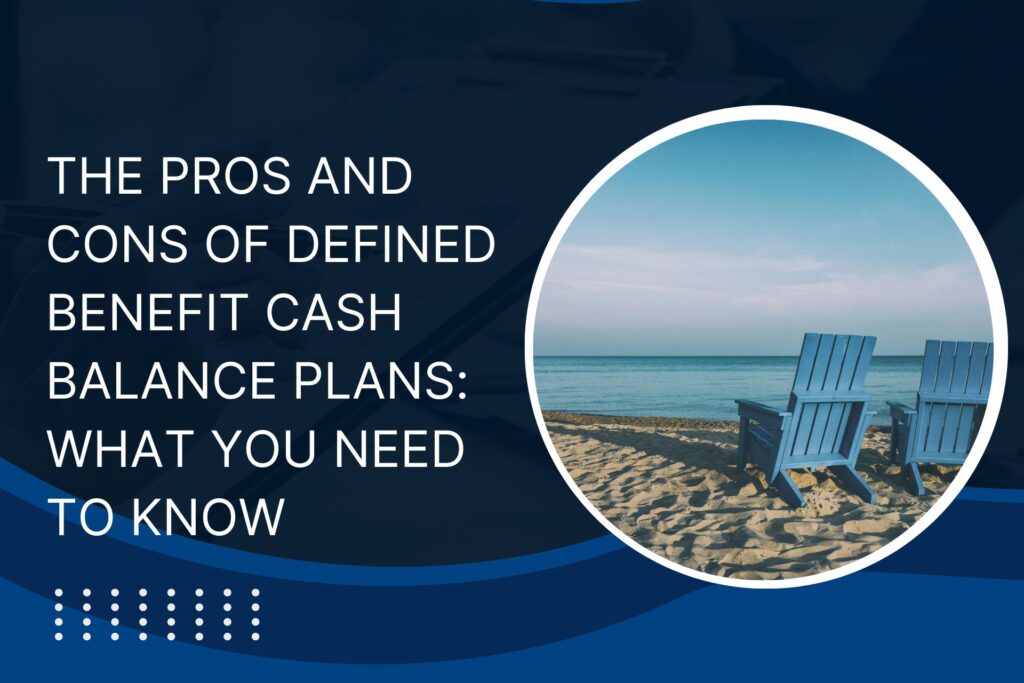Welcome to the world of retirement planning! When it comes to securing your financial future, understanding the ins and outs of different retirement plans is crucial. One such plan that has gained popularity in recent years is the defined benefit cash balance plan. Designed to provide employees with a guaranteed retirement income, this unique plan combines elements of both defined benefit and defined contribution plans. However, like any retirement plan, it’s important to weigh the pros and cons before making a decision.
In this article, we will explore the advantages and disadvantages of defined benefit cash balance plans, helping you make an informed choice about your retirement savings. So, whether you’re an employer looking to offer a competitive benefits package or an employee planning for the future, join us as we dive into the world of defined benefit cash balance plans and discover what you need to know.
Understanding the Pros of Defined Benefit Cash Balance Plans
Defined benefit cash balance plans offer several advantages that make them an appealing option for both employers and employees. Firstly, these plans provide a predictable retirement income for employees, ensuring financial security during their golden years. Unlike defined contribution plans, where the retirement income is subject to market fluctuations, defined benefit cash balance plans guarantee a specific benefit amount based on a predetermined formula.
Another advantage of defined benefit cash balance plans is that they are portable. This means that if an employee leaves their current job, they can transfer their cash balance to another retirement plan or roll it over into an individual retirement account (IRA). This portability provides flexibility and ensures that employees can continue to build their retirement savings, regardless of their employment status.
Additionally, defined benefit cash balance plans offer tax advantages for both employers and employees. Contributions made by employers to these plans are tax-deductible, reducing their taxable income. For employees, the contributions made on their behalf are not subject to income tax until they start receiving distributions during retirement.
However, it’s important to note that there are some potential drawbacks to consider when it comes to defined benefit cash balance plans. Let’s explore these in the next section.
Exploring the Cons of Defined Benefit Cash Balance Plans
One of the main disadvantages of defined benefit cash balance plans is the potential for higher costs compared to other retirement plans. Employers are responsible for funding the promised benefits, which means they may need to make significant contributions to the plan. This can be a financial burden, especially for small businesses or those operating in industries with high employee turnover rates.
Another drawback of defined benefit cash balance plans is the lack of investment control for employees. Unlike defined contribution plans, where employees can choose how their contributions are invested, in a defined benefit cash balance plan, the investment decisions are made by the employer or plan administrator. This lack of control can be frustrating for employees who want to have a say in how their retirement savings are managed.
Additionally, defined benefit cash balance plans may not be suitable for employees who prefer flexibility and control over their retirement savings. These plans offer a fixed benefit amount, which means employees cannot access their funds until they reach a certain age or meet specific criteria. This lack of liquidity can be a disadvantage for individuals who may have unexpected financial needs or prefer to have more control over their retirement funds.
Now that we’ve explored the pros and cons of defined benefit cash balance plans, let’s compare them to other retirement options to see how they stack up.
Comparing Defined Benefit Cash Balance Plans to Other Retirement Options
When it comes to retirement planning, there are several options available, each with its own set of advantages and disadvantages. Let’s compare defined benefit cash balance plans to two popular alternatives: defined contribution plans and individual retirement accounts (IRAs).
Defined contribution plans, such as 401(k) plans, offer employees the opportunity to save for retirement by making contributions to their individual accounts. These plans provide flexibility and control, as employees can choose how their contributions are invested. However, the retirement income is not guaranteed and is subject to market fluctuations. In contrast, defined benefit cash balance plans offer a fixed benefit amount, providing employees with more certainty about their retirement income.
Another popular retirement option is the individual retirement account (IRA). IRAs allow individuals to save for retirement on their own, outside of an employer-sponsored plan. While IRAs offer flexibility and control over investment decisions, the contribution limits are lower compared to defined benefit cash balance plans. Additionally, IRAs do not provide the same level of guaranteed retirement income as defined benefit cash balance plans.
It’s important to carefully consider your retirement goals, risk tolerance, and financial situation when choosing between these options. Now, let’s take a closer look at the key considerations for employers considering a defined benefit cash balance plan
Key Considerations for Employers Considering a Defined Benefit Cash Balance Plan
For employers, offering a defined benefit cash balance plan can be an attractive way to attract and retain top talent. However, there are several key considerations to keep in mind before implementing such a plan.
Firstly, employers should assess their ability to fund the promised benefits. Unlike defined contribution plans, where the employer’s contribution is fixed, defined benefit cash balance plans require ongoing contributions based on the predetermined formula. Employers should carefully evaluate their financial situation and projections to ensure they can meet these obligations.
Additionally, employers should consider the demographics of their workforce. Defined benefit cash balance plans may be more beneficial for older employees who are closer to retirement, as they offer a guaranteed income stream. Younger employees, on the other hand, may prefer the flexibility and control offered by defined contribution plans. It’s important to strike a balance and offer a retirement plan that meets the needs of all employees.
Furthermore, employers should consider the administrative requirements and costs associated with setting up and maintaining a defined benefit cash balance plan. These plans require actuarial calculations, regular funding, and compliance with regulations. Employers should carefully evaluate their resources and determine if they have the capacity to handle these responsibilities in-house or if they need to outsource to a third-party administrator.
Now that we’ve discussed the key considerations for employers, let’s delve into the process of setting up and administering a defined benefit cash balance plan.
How to Set Up and Administer a Defined Benefit Cash Balance Plan
Setting up and administering a defined benefit cash balance plan requires careful planning and expertise. Here’s a step-by-step guide to help employers navigate this process:
1. Determine eligibility criteria:
Employers should establish criteria for employees to participate in the plan, such as age and years of service requirements.
2. Define the benefit formula:
Employers need to determine the formula for calculating the cash balance credits, taking into account factors such as salary and years of service.
3. Choose a plan administrator:
Employers can choose to handle the administration in-house or outsource it to a third-party administrator, such as a retirement plan consultant or a financial institution.
4. Conduct actuarial calculations
Actuarial calculations are needed to determine the annual contributions required to fund the promised benefits. This step requires the expertise of an actuary.
5. Develop a communication strategy:
Employers should develop a communication strategy to educate employees about the plan and provide regular updates on their retirement benefits.
6. Monitor the plan
Employers should regularly monitor the plan’s performance, review the funding requirements, and make any necessary adjustments to ensure compliance with regulations.
By following these steps and seeking professional guidance, employers can successfully set up and administer a defined benefit cash balance plan. However, it’s important to be aware of the common challenges and misconceptions associated with these plans, which we’ll explore next.
Calculate your Retirement Plans Today!
Calculate Now!Common Challenges and Misconceptions about Defined Benefit Cash Balance Plans
While defined benefit cash balance plans offer many advantages, they also come with their fair share of challenges and misconceptions. Let’s address some of the most common ones:
1. Misconception: Defined benefit cash balance plans are only suitable for large corporations.
Reality: While these plans are more commonly associated with large corporations, small businesses can also benefit from offering a defined benefit cash balance plan. With the help of a retirement plan consultant or a financial institution, small businesses can design a plan that meets their needs and budget.
2. Challenge: Compliance with regulations and reporting requirements.
Solution: Defined benefit cash balance plans are subject to specific regulations and reporting requirements. Employers should ensure they stay up to date with the latest rules and work with professionals who specialize in retirement plan administration to ensure compliance.
3. Misconception: Defined benefit cash balance plans are too expensive.
Reality: While it’s true that defined benefit cash balance plans can be more costly compared to other retirement plans, employers have the flexibility to control the level of benefits offered. By carefully designing the plan and managing funding levels, employers can strike a balance between providing competitive benefits and managing costs.
4. Challenge: Employee understanding and engagement.
Solution: Educating employees about the benefits of a defined benefit cash balance plan is crucial for their engagement and participation. Employers should provide clear communication materials, hold informational sessions, and offer personalized guidance to help employees make informed decisions about their retirement savings.
Now that we’ve addressed some common challenges and misconceptions, let’s dive into real-life case studies to learn from companies that have successfully implemented defined benefit cash balance plans.
Expert Advice and Tips for Maximizing the Benefits of Defined Benefit Cash Balance Plans
To wrap up our exploration of defined benefit cash balance plans, let’s hear from retirement planning experts on how to maximize the benefits of these plans:
1. Foster employee engagement:
Regularly communicate with employees about the plan, provide educational resources, and offer personalized retirement planning assistance to help employees make informed decisions.
2. Seek professional guidance:
Work with retirement plan consultants and actuarial experts to ensure compliance with regulations, make accurate funding projections, and optimize the design of the plan.
3. Continuously evaluate the plan:
Regularly review the plan’s performance, funding levels, and employee demographics to ensure it remains aligned with the company’s goals and the needs of its workforce.
4. Consider plan design options:
Explore different plan design options, such as tiered benefit structures or age-weighted formulas, to tailor the plan to the specific needs of the company and its employees.
By following these expert tips and leveraging the expertise of professionals, employers can make the most of their defined benefit cash balance plans and provide their employees with a valuable retirement benefit.
Conclusion: Is a Defined Benefit Cash Balance Plan Right for Your Company?
In conclusion, defined benefit cash balance plans offer a unique combination of guaranteed retirement income and flexibility. These plans can provide employees with financial security during their retirement years, while also offering employers a competitive edge in attracting and retaining top talent. However, it’s important to carefully consider the pros and cons, compare them to other retirement options, and evaluate your company’s specific needs before making a decision.
If you’re an employer, take into account factors such as your financial resources, employee demographics, and administrative capabilities. Seek professional guidance to ensure compliance with regulations and optimize the design of the plan. For employees, consider your retirement goals, risk tolerance, and desire for control over your retirement savings.
By weighing the advantages and disadvantages, considering expert advice, and understanding the experiences of other companies, you can make an informed choice about whether a defined benefit cash balance plan is right for your company. Remember, retirement planning is a long-term commitment, and choosing the right plan can make a significant impact on your financial future. So, take the time to explore your options and make a decision that aligns with your goals and priorities.


